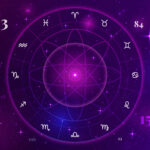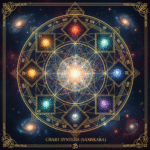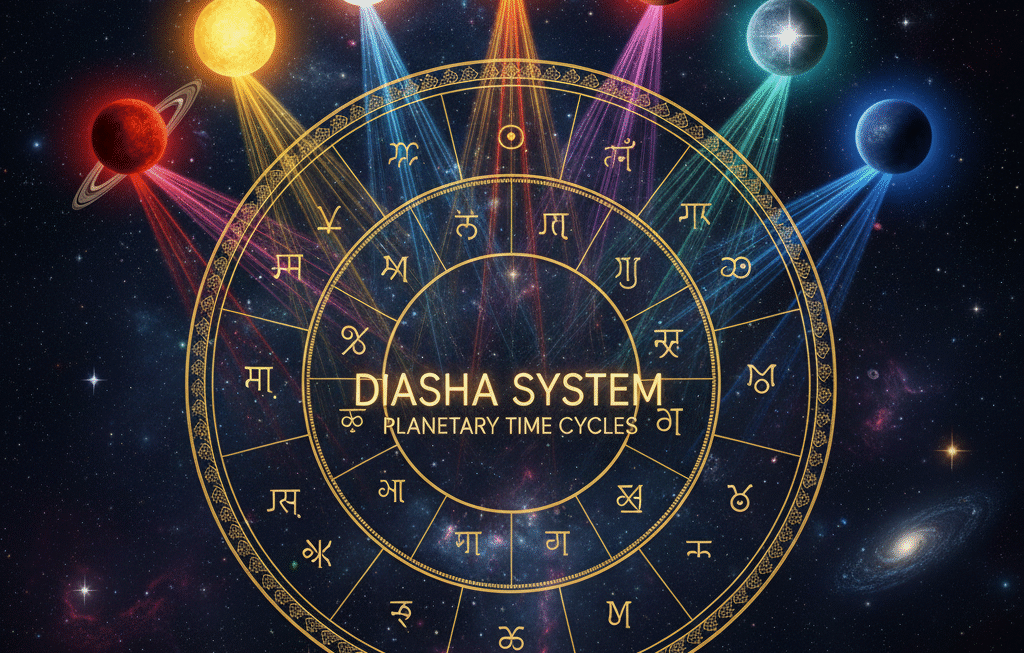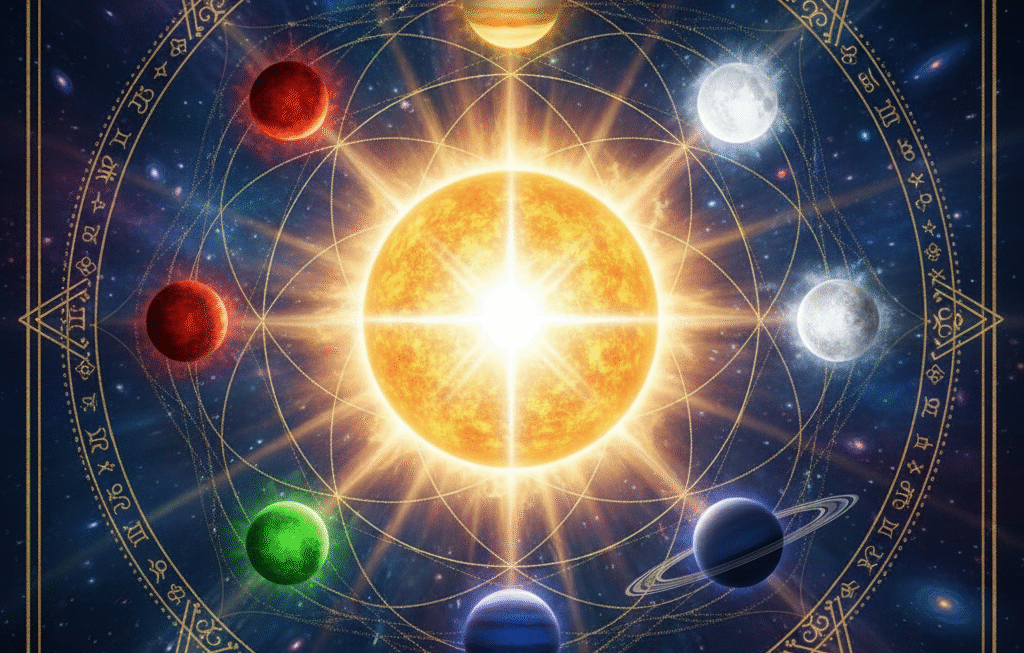If you’ve ever looked at your Vedic birth chart (Kundli) and wondered why certain planetary combinations seem harmonious while others bring challenges, the answer lies in the system of planetary friendship and enmity, known in Sanskrit as Graha Maitri.
In Vedic astrology, every planet has its own personality, just like people do. Some planets share natural harmony, others have subtle tension, and a few have outright rivalry. Understanding these relationships helps you interpret your chart more intelligently — especially when multiple planets occupy the same house or aspect each other.
Let’s explore this fascinating concept step-by-step.
What Is Planetary Friendship in Vedic Astrology?
(Keywords: planetary friendship, graha maitri)
Opinion: Planetary friendship (Graha Maitri) describes the natural relationship between the planets, based on their inherent qualities and mythological connections.
Reason: Each planet (Graha) has a specific nature — some are benefic, others malefic; some represent intellect, others emotion or discipline. Depending on their cosmic temperaments, they either cooperate or conflict with one another.
Example: The Moon and Mercury are friendly because both represent the mind — fluid, adaptive, and communicative. But Mars and Mercury clash, as Mars acts impulsively while Mercury analyzes carefully.
Restatement: Therefore, understanding planetary friendship helps us decode how planets behave when they interact — whether they amplify each other’s blessings or produce internal friction.
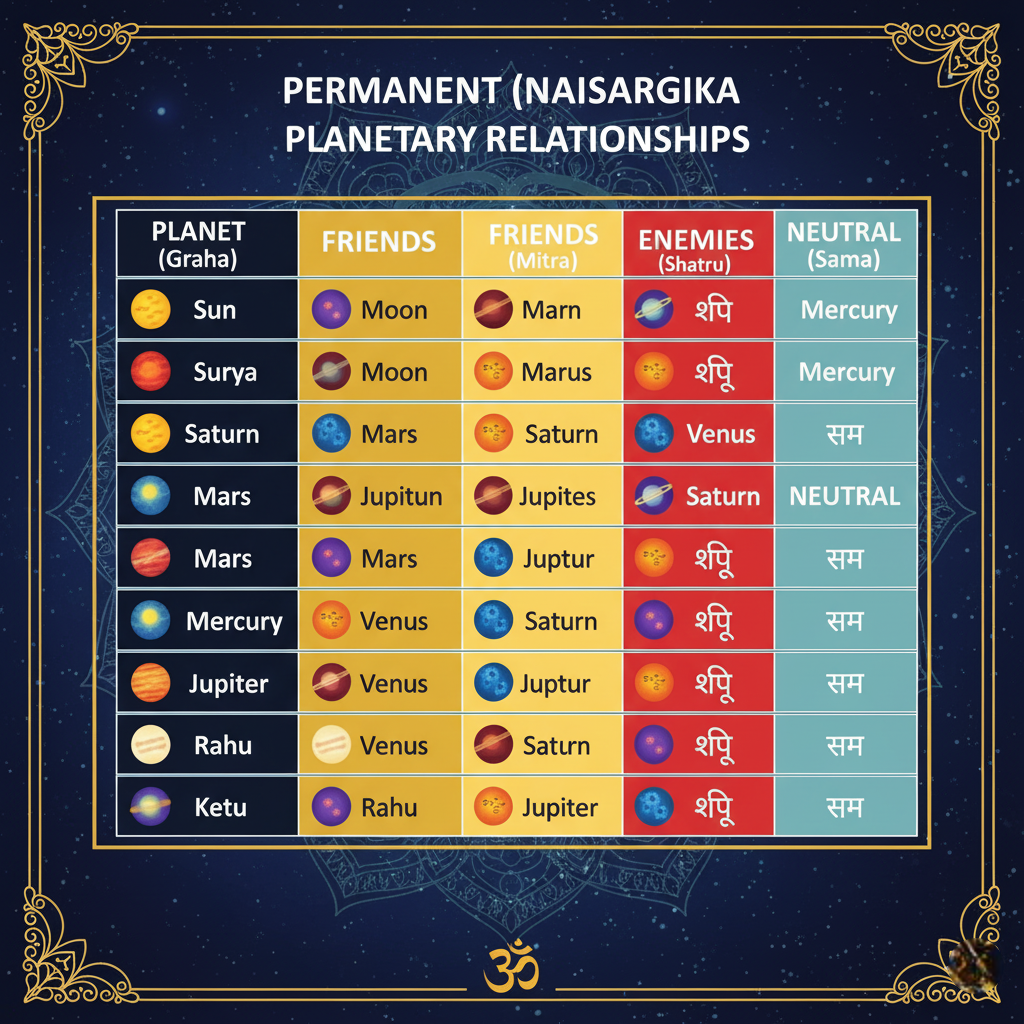
The Three Levels of Planetary Relationships
In Vedic astrology, planetary friendship is classified into three levels:
- Natural Friendship (Naisargika Maitri) – Permanent, innate relationship among planets.
- Temporary Friendship (Tatkalika Maitri) – Temporary relationship based on their placement in your birth chart.
- Compound (Fivefold) Friendship (Panchadha Maitri) – The final relationship after combining both natural and temporary friendships.
Let’s understand each in detail.
1. Natural Friendship (Naisargika Maitri)
Every planet has a set of natural friends, enemies, and neutrals, irrespective of their placement.
Here’s the classical table of natural relationships as per Brihat Parashara Hora Shastra:
| Planet | Friends | Enemies | Neutrals |
| Sun | Moon, Mars, Jupiter | Venus, Saturn | Mercury |
| Moon | Sun, Mercury | None | Mars, Jupiter, Venus, Saturn |
| Mars | Sun, Moon, Jupiter | Mercury | Venus, Saturn |
| Mercury | Sun, Venus | Moon | Mars, Jupiter, Saturn |
| Jupiter | Sun, Moon, Mars | Mercury, Venus | Saturn |
| Venus | Mercury, Saturn | Sun, Moon | Mars, Jupiter |
| Saturn | Mercury, Venus | Sun, Moon | Mars, Jupiter |
Interpretation:
- Friendly planets strengthen each other when associated.
- Enemy planets create friction, confusion, or obstacles.
- Neutral relationships produce mild or mixed results.
2. Temporary Friendship (Tatkalika Maitri)
This is a chart-based relationship.
Two planets become temporary friends if they are placed:
- 2nd, 3rd, 4th, 10th, 11th, or 12th from each other.
They become temporary enemies if placed in: - 1st, 5th, 6th, 7th, 8th, or 9th houses from each other.
Example:
If the Sun is in Aries and Venus is in Taurus (2nd from Sun), they become temporary friends — even though they are natural enemies.
This rule shows how circumstantial proximity can alter relationships — just like in real life!
3. Compound Friendship (Panchadha Maitri)
Now comes the most important level: the final relationship formed by combining natural and temporary friendship.
The results are interpreted as follows:
| Natural | Temporary | Final (Panchadha Maitri) |
| Friend | Friend | Best Friend |
| Friend | Neutral | Friend |
| Friend | Enemy | Neutral |
| Enemy | Friend | Neutral |
| Enemy | Neutral | Enemy |
| Enemy | Enemy | Bitter Enemy |
Example:
Let’s say Venus and Saturn are natural friends. If they’re placed in 3rd and 11th houses (temporary friends), they become Best Friends in the chart — giving strong mutual support.
Why Planetary Friendship Matters in Chart Analysis
Opinion: The concept of Graha Maitri is fundamental to understanding how planets interact in your Kundli.
Reason: Even if two benefic planets are present in a house, they may not produce harmonious results if they’re natural enemies. Conversely, two malefics can yield constructive energy if they are friendly toward each other.
Example:
- Mars + Sun: Both fiery and natural friends — create leadership, energy, courage.
- Venus + Sun: Natural enemies — may cause conflict between pleasure and duty.
- Mercury + Moon: Unstable friendship — intellect (Mercury) may battle emotions (Moon).
Restatement: So before judging any yoga (planetary combination), always ask — “Are these planets friends or foes?”
Planetary Friendship and House Lords
Friendship also helps determine house lord relationships.
For example:
- If the 1st lord (Lagna Lord) and 9th lord are friends → excellent for fortune and health.
- If 5th and 7th lords are enemies → may create love-marriage conflicts.
- If 2nd and 11th lords are friendly → strong wealth potential.
💡 Pro Tip: When analyzing yogas (like Dhana Yoga, Raja Yoga, etc.), first verify the Graha Maitri between the involved lords — it determines how smoothly the yoga will manifest.
Psychological and Spiritual Interpretation
Beyond technicality, planetary friendship shows how different aspects of your personality cooperate or compete.
- A friendly relationship between Moon and Mercury = harmony between emotions and intellect.
- A hostile relationship between Venus and Saturn = struggle between desire and discipline.
- Friendship between Jupiter and Sun = balance between wisdom and leadership.
In this sense, Graha Maitri is not just about planets — it’s about your inner dynamics. It reveals which energies within you naturally align and which require conscious integration.
Step-by-Step: How to Analyze Graha Maitri in Your Own Chart
Let’s make it practical:
- List all planetary placements.
Example: Sun (Leo), Moon (Taurus), Mercury (Virgo), etc. - Identify pairs that form conjunctions or aspects.
These planets interact directly and need relationship analysis. - Check their Natural Friendship from the table above.
- Check their Temporary Friendship based on house positions.
- Combine both to find their final relationship (Panchadha Maitri).
- Interpret the impact based on house and sign.
- Friendly planets = mutual support, positive outcomes.
- Enemies = tension, inner conflict, external challenges.
- Friendly planets = mutual support, positive outcomes.
Common Misunderstandings About Planetary Friendship
Myth 1: “Enemy planets always cause harm.”
Truth: Even enemy planets can yield positive results if strong or well-placed. Their conflict produces growth through challenge.
Myth 2: “Friendship never changes.”
Truth: Temporary friendship can modify natural hostility, especially in chart-specific contexts.
Myth 3: “Only benefic planets can be friends.”
Truth: Malefics like Mars and Saturn can be excellent allies in ambition, structure, and endurance.
Final Thoughts: The Cosmic Web of Relationships
Every chart is a universe of interactions. Your planets are like cosmic personalities conversing within you — sometimes arguing, sometimes supporting, but always guiding your growth.
Understanding Graha Maitri allows you to:
- Decode the harmony or tension between life themes.
- Predict how yogas manifest — smoothly or with struggle.
- Evolve spiritually by integrating conflicting energies.
When you see your planets not as “good or bad” but as friends and teachers, your birth chart becomes a living dialogue of cosmic intelligence.



